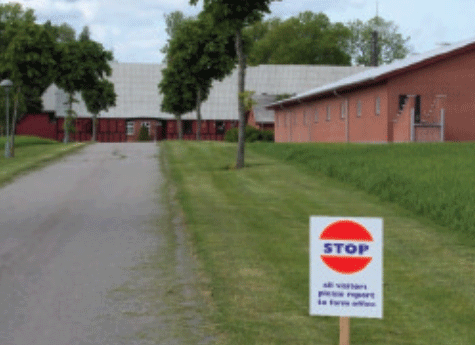



Biosecurity
Tips on keeping disease out of pig farms in No. 13 in the series 'Action for Productivity' from BPEX.The unit location, including the distance from other pigs or a potentially infected site is a very important factor affecting a unit’s biosecurity. However, since changing the location to reduce the risk of infection is rarely an option, the unit should be carefully assessed to evaluate the potential risks and steps taken to minimise the risk as far as possible.
The most common method of disease transmission is direct pig-to-pig contact, with the highest risk of introducing a disease usually through infected stock. Other methods that can spread diseases include:
- Airborne eg windborne spread from neighbouring unit
- Mechanical eg vehicles, machinery and equipment
- People, footwear and clothing
- Birds, rats, mice, insects and other animals (domestic, farm and wildlife)
- Contaminated feed, water, semen, bedding etc
The method of transmission depends on the individual disease. Before any disease can be transmitted enough live organisms must come into contact with the pig. Biosecurity involves minimising or diluting this risk. Hygiene, cleaning and disinfection are therefore integral parts of any biosecurity program. A biosecurity program should form part of your herd health plan and you should develop a routine for reassessing the risks at regular intervals.
Management Guidelines
Incoming Stock
- When setting up contracts for deliveries of new stock, both breeding gilts and weaners, check the health status of the source before introducing them to the main herd; get your vet to speak to their vet
- Isolate all incoming replacement breeding stock in suitable facilities (ideally situated on the perimeter of the unit), operated on an all-in all-out basis and cleaned and disinfected between batches
- Where possible use a separate, secure site, with separate staff and equipment
- Discuss and agree a suitable isolation and acclimatisation programme with your vet, taking into consideration duration (ideally six to eight weeks), testing and vaccination requirements
Access
- Define ‘clean’ and ‘dirty’ areas and control all access onto the unit (the clean area) through clear access points
- Provide obvious signs with instructions at access points
- Provide a bell or horn for visitors/delivery drivers to attract attention
Vehicles
- Keep vehicles outside the perimeter of the unit
- Only allow the unit’s own vehicles and machinery to enter, clean and disinfect if they have been off site
- Control the areas accessible by vehicles (including feed and livestock vehicles), keeping them as far away from the buildings and livestock as possible
Loading Bay
- Site the loading bay on the perimeter of the unit, away from pig buildings and paddocks
- Design or redesign it so that it can be easily cleaned and so that there is easy control of livestock movement and so that there is no contact between farm staff and the vehicle and driver
- If boots are not provided for the drivers, provide a disinfectant foot dip and brush and renew it every time the loading bay is used
- Clean and disinfect after each use; the design should ensure that water drains away from the unit after cleaning
Visitors (minimum standard)
- Visits should be prearranged wherever possible
- Entry should be via a single entry point, where clean boots and overalls are provided and visitors can wash their hands
- A ‘Visitors Book’ must be provided and completed by all visitors before entry, confirming that they are complying with the unit requirements
Staff (minimum standard)
- Give staff the information and training they need to maintain strict standards of hygiene and biosecurity
- Overalls and boots used on the unit should be worn specifically on that unit and where possible be washed and cleaned on the unit itself
- Ensure staff are aware of the risks associated with coming into contact with pigs outside of work eg at agricultural shows
Vermin, Birds, Flies and Pets
- Have an active rodent and pest control system in place and check regularly that it is working
- Keep the unit clean and tidy
- Control birds where possible, for example by ensuring lids are kept on feed hoppers and that feed spills are cleaned up promptly
- Keep pets away from the unit
Feed Bins
- Where possible locate feed bins on the perimeter of the unit to prevent vehicles from having to enter the unit
- Bulk feed pipes should be provided for use with all deliveries, rather than using the vehicles’ own pipes
- Regularly empty and clean bulk bins, ensuring that they remain watertight and dry
Water
- Water storage tanks must be clean, rat/bird proof and lidded where appropriate
- If the water supply is not from the mains, test it regularly for bacteria and contamination
Bedding Material
- Store straw, shavings, paper bedding etc safely to prevent contamination by vermin and protect it from the weather
- Straw should come from a ‘safe’ source ie not from where it might have been exposed to livestock or their manure
Machinery and Equipment
- Avoid bringing machinery or equipment on to your farm unless it is essential
- Any equipment brought onto the unit must first be thoroughly cleaned and disinfected; this includes machinery used for manure and/or slurry handling
- Apply the same biosecurity procedures as for feed equipment and deliveries
Dead Pig Disposal
- Dispose of dead stock promptly and correctly
- Provide safe sealed storage for dead pigs in line with legal requirements
- Where collection is by a third party, provide a collection point away from the pig housing with clear demarcation between the farm access and the collection service access
- Keep the collection point and associated equipment clean and disinfect after every use

May 2013








